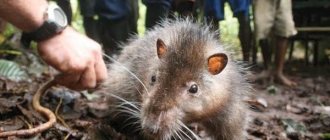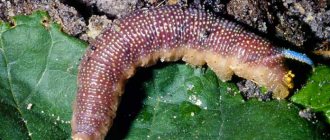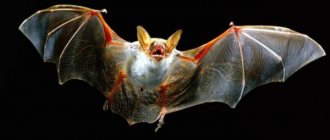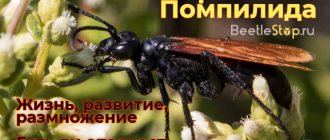Appearance and characteristics
As a description of the wasp, it should be noted that the insect has a length of 3-5.5 cm. The wingspan will correspond to 5 cm. The female is larger in size than the male. Apart from their size, they are distinguished from ordinary wasps by the presence of 2 round spots of a bright yellow hue on the 2nd and 3rd abdominal segments. A similar spot, but smaller in size, is located on the scutellum. Other parts of the body are covered with red hairs.
Externally, the black hornet and the giant wasp are similar. The body is divided by a “waist”; insects have developed legs that are covered with pile. Also noteworthy is the red head.
Common types of Scolia
To recognize these insects in natural conditions, you need to understand how they differ from each other. In total, there are about 100 species that belong to this family.
Giant Scolia
It is found in North Africa, Crimea, Central Asia, the Middle East, and Southern Europe. Scolia is a giant insect found in Russia (Caucasus). Its difference is that it is thermophilic, so in very cold soil the offspring die. Interestingly, the giant scolia is listed in the Red Book.
The female develops to large sizes (55 mm), and the male - only up to 32 mm. The lifestyle of young animals is no different from the process of development of the offspring of other species - they parasitize on beetle larvae. Closer to May, an adult is released from the pupa. She looks for food for herself during the day and rests on the forest floor at night. Scolia giant cannot feed on the nectar of any flowers; the length of its proboscis does not allow it to do so. For this reason, the insect obtains food on certain plants - those with a shallow corolla.
Capita scolia (Java)
It is less common than its giant counterparts. The body length is larger (up to 60 mm), the color is black, yellow spots on the head are noticeable. The wingspan reaches 100 mm. Males, as usual, are much smaller. Due to its large size and dark body color, the insect is called a black giant. The insect lives in Indonesia, where it is respected by the locals, as it destroys sugar cane pests.
Stepnaya
Distribution across the planet: southeast China, Primorye and Japan. Gradually, representatives of this species populate Altai, Siberia, and the forest belt of Russia. Steppe Scolia is small in size: up to 22 mm (males), up to 18 mm (females). Hairs are visible on the body. Food for adults is plant pollen. The lifestyle of larvae is not much different from the life activity of fellow species of other species. For the winter, the young hide under a layer of soil (up to 40 mm below the surface).
Habitat and lifestyle
According to the description, in natural conditions Scolia is a predator. She hunts small pests that eat agricultural crops. In this regard, it can be said that the giant wasp is beneficial for agriculture and gardening. In a number of countries, such insects are deliberately introduced into reed plantations to counteract the tropical rhinoceros beetle.
Pests are common in southern Europe, Africa and Asia. In Russia, the giant wasp is found in the Caucasus and the south. But due to climate change, wasps are spreading to other areas.
Scolia leads a diurnal lifestyle. The wasp spends the night in the forest floor. Preparations for laying eggs begin in the last weeks of summer. Around the same time, the Scolia prepares food for the young.
Scolia wasps - benefits and harms
Despite the impressive size and threatening appearance of some species of Scolia, meeting them in nature is almost not dangerous for humans and animals. These wasps sting not as painfully as many of their other relatives, and the toxicity of the venom is inferior to that of other wasps. In addition, unlike social wasps, scolia do not attack their offender in a swarm.
The disposition of these insects can generally be called peaceful. A disturbed wasp prefers not to enter into conflict, even if the object that disturbed it behaves intrusively. The insect most often slowly leaves the scene of the collision or continues to go about its business.
By collecting nectar, wasps actively participate in flower pollination. Scolia are very useful as destroyers of harmful insects. They kill many beetles and their larvae, which spoil the harvests of grain and fruit crops. Therefore, many owners of gardens, vegetable gardens and fields are not at all opposed to seeing these wasps on their land, and some even specifically breed them on their plots.
Reproduction and nutrition
The offspring will go through several stages:
- egg;
- larva;
- doll
Next, the transformation into an adult insect occurs. The wasp will provide food for its own offspring. For these purposes, she looks for small pests in the form of larvae:
- rhinoceros beetle;
- bronze;
- May beetles.
The wasp's task will be to immobilize its victim. Taking into account the fact that its young act primarily as parasites, it is necessary to deliver the prey alive. The wasp uses its sting to neutralize the nervous system of its prey.
The next stage is the laying of eggs in the body of the victim. If a larva forms, it will begin to feed, destroying the least important organs first. At the end there will be the circulatory system and the central nervous system. The duration of this process is 12 days. Growth is associated with molting (noted 3 times). Having finished feeding, the larva will prepare a cocoon inside the dead insect. This will take approximately 24 hours. The cocoon resembles an ellipse. The length will vary: 1.8-2.5 cm. The protective shell is formed with the help of the salivary glands that produce silk thread. The next stage is the formation of the pupa. This condition lasts approximately 4 weeks. In April, an adult wasp emerges from the cocoon. Its tasks are:
- continued reproduction;
- food production (flower nectar);
- creating a hole.
It should be noted that the wasp does not have a specific structure in the hole. The insect moves chaotically, choosing different places to enter the soil. The hole will be destroyed if the giant wasp leaves its own home.
Basically, the giant scolia's burrow is located near a potential victim.
Wasps hunt prey whose nerve ganglia are close together. Having found it, the female goes on the attack - she bites directly into the abdominal nerve, which controls coordination. Thanks to this, the wasp does not kill the victim, but immobilizes it. This allows food to remain fresh for a long period of time.
Eating also has characteristic features - initially the secondary organs are eaten, and then the main ones. When this sequence is disrupted, after an extremely short period of time the prey will begin to decompose. However, in nature these errors are impossible. Scolia hunts underground, so its actions are not visible to observers.
General description of the family
Appearance
Adult scolias, depending on the species, reach a length from 10 mm to 6 cm (sometimes more), the wingspan of large individuals is up to 10 cm. Females are more massive than males, males look weaker compared to females.
Most species are black with yellow, white, red or orange spots and stripes. The females of some species have wings the color of onion skins with a purple sheen. The body of many species of Scolia is densely covered with hairs.
Lifestyle
Unlike social wasp species, Scolia do not have such a developed communication system. This is not necessary, since Scolia are solitary wasps. In general, the family is more primitive than social wasps, and their behavior is not nearly as complex. But a lot of unusual things are present in everything that concerns feeding and breeding of offspring in these insects.
Nutritional Features
Adults feed on flower nectar, and to feed their larvae they use the larvae of other insects, mainly lamellar beetles: rhinoceroses, Hercules beetles, May beetles, bronze beetles, and Khrushchev beetles. The choice of Scolia is explained by the special arrangement of the nerve ganglia in these insects - they are close together, so they are easy to hit with one sting injection.
Having found a suitable victim, the wasp stings it in the nerve ganglion, thereby paralyzing, but not killing. Then she lays her larva on the belly of the insect, which gradually eats “live canned food” as it grows. In this unusual way, predators solve the issue of storing fresh meat.
An immobilized victim can live for a long time. The Scolia larva eats it in about 12 days, leaving only the shell. It begins to eat the victim from the less vital organs, leaving the circulatory and nervous systems last, so the insect remains alive for a long time.
Reproduction and development
Scolia begin to resolve issues related to procreation towards the end of summer. By this time, fertilized females are already planning victims who will be destined to become food for their larvae.
In the photo, a wasp paralyzed a cockchafer larva
Not far from the place where the wasp noticed a suitable insect larva, it digs a hole in the ground, then drags the paralyzed victim into it, and there, underground, lays one of its larvae on it. Then the adult wasp leaves the burrow, the entrance of which is covered with earth. Then the larva grows and develops without her participation. The wasp digs a separate hole for each larva.
After the future Scolia eats an insect, it begins to weave an elliptical cocoon, transforming the secretion of the salivary glands into a silky thread. It takes her days to do this. The larva spends winter hibernation in the cocoon, and in the spring it emerges as an adult insect.
A bite of an insect
Despite the fact that insects bite rarely, help may be required. This is due to the fact that the reaction to poison differs in each individual organism. A characteristic feature of a giant wasp bite is that it bites without landing on the skin.
Symptoms and consequences
When the bite was made by one wasp, it will not provoke dangerous health complications. The poison penetrates in small quantities, and timely measures taken will help eliminate the problem as soon as possible. When a person is bitten by several scolias at once, this can provoke a state of shock. There is a risk of death from an allergic reaction in 2% of people. In rare situations, even 1 bite is enough.
A person’s heart rate increases, dizziness, nausea, gag reflex, and convulsions appear. A complicated reaction that occurs after a giant wasp sting is anaphylactic shock. The victim may lose consciousness. This reaction requires immediate medical attention. Complications from a bite are much more dangerous for the following groups of people:
- children;
- people with allergies;
- having diabetes, asthma;
- aged people;
- pregnant women.
Scolia, despite its impressive size, is considered less dangerous than an ordinary wasp. For the human body, insect venom is weaker. It only stings in self-defense.
The benefits of the giant wasp are much greater than the harm. Scolia populations become smaller every year, which can trigger their eventual extinction.
First aid
First of all, it is necessary to make sure what kind of insect made the bite, whether it is really scoliosis. If poison has penetrated into the body, then it is necessary to prevent its further spread. It is forbidden to squeeze it out from the bite site, as there is a possibility of infection. Immediate measures:
- It is necessary to disinfect with alcohol, hydrogen peroxide or iodine.
- You need to drink plenty of fluids.
- To slow down the absorption of the poison, apply a cooled heating pad, a damp towel or an application of soda to the affected area (1 teaspoon of the ingredient per 0.2 liters of water). A lump of soaked sugar also helps draw out the poison.
- To prevent an allergic reaction, it is recommended to use antihistamines.
- The main remedy for relieving swelling and counteracting pain is chilled applications.
- If the affected area is large, you can take diphenhydramine. When blood pressure has decreased, use cordiamine.
- Alcohol must be avoided, as it significantly increases swelling and worsens well-being.
Allergic reaction
Contact with any wasps can trigger the formation of allergies. A one-time injection of a toxic substance is not enough for dangerous complications to develop. Meanwhile, there is no need to fear the attack of many giant wasps, since they live alone.
In any case, you need to be extremely careful when such an insect is detected nearby. Scolia's bite is quite painful. In addition, sometimes the same reaction occurs as when contacting an encephalitis tick.
If the body is overly sensitive, an allergic reaction is formed due to the bite of one adult scolius. However, this happens much less frequently.
Report No. 2
Wasps are very interesting stalked-bellied hymenoptera, strongly stinging insects; some of their species live alone, some in large colonies. A single wasp lives solitary, may not build nests, all of their adults can reproduce. Species of social wasps build secure nests and live in large families. They reproduce by queen, like their relatives bees; the basis of the colony is made up of worker wasps.
Classification
Specialist biologists distinguish between species of flower wasps and burrowing wasps, the often parasitic wasps and German wasps, extremely skilled pottery wasps. They are very interesting in their way of life among related species of Typhia and Scolia. Most often found in nature are real and paper wasps. Road wasps and sand wasps build their nests in a special way. Everyone has once encountered hornets that buzz loudly and have a menacing bite.
Wasps are loners
These types of wasps can build nests that are very different in location and configuration. Thus, earth-dwelling wasps and similar so-called flower wasps build nests with brood cells in any protected places, attaching them to the walls of buildings. Pottery wasps make their mud nests to look like vases or jugs. Wasps can burrow into the ground, into secluded places under the bark of trees, into small holes and natural depressions. A solitary wasp lays one egg per cell and seals it tightly; adult wasps and brood practically do not interact. The cells for males are often smaller, and as adults they are smaller than female workers.
Social wasps
The life of a social wasp is subject to strict instincts; they build nests according to strict rules and organize the life of the family. The construction of the nest is initiated by the queen, then the hatched females begin to gradually help her, and then generally release her from this duty. The queen gradually focuses only on producing new offspring. By the size of the nest you can always understand how many working individuals live in the family.
The total number of workers in a family of wasps can reach several thousand. In wasps, like other Hymenoptera, there are stages of what biologists call the transition from a solitary wasp to a social wasp. Social wasps that build large nests have natural parasitic enemies. First of all, these are other types of wasps: the German wasp and the glossy wasp, as well as the ichneumon wasp and the hoverfly, can be parasitized.
Class 2, 3 description, species, where they live, what they eat
Main types of hornets
There are 23 species that have a similar way of life, diet, and reproduction characteristics. However, each of them has significant differences in appearance. The most common types of hornet in the photo:
- Common hornet. The most common species, found mainly in Europe. The variety is also present in North America. The dimensions of the working individual are 20-22 mm, the uterus is 30-35 mm.
- Asian giant. The largest species, with a record size for a wasp - up to 10 cm. The predator lives in Asia and is represented by several subspecies. A distinctive feature is a bright yellow head and black wide stripes on the body. This is one of the most dangerous hornets, since the venom is extremely toxic and can even cause human death.
- Black. This wasp is common in Asian countries and in some regions of Russia (Amur region, Transbaikalia). The insect is characterized by a parasitic lifestyle. The female is not as busy caring for her offspring as other species. It penetrates a colony of large wasps of another species, kills the queen, and takes her place.
All types of wasps have toxic venom for protection and successful hunting.
Is it worth declaring war?
From all that has been said, we can draw an unambiguous conclusion - despite its terrifying size, Scolia is one of the safest representatives of the wasp family for humans. He is of no interest to them, and the attack should only be in self-defense. In addition, the poison they secrete is much weaker than that of most other members of this family. Another undoubted advantage of the presence of skolia on the site is the reduction of populations of pest beetles.
If you think that being around giant wasps is unacceptable, you can try using insecticides. But this method is rather dubious, since scolias do not have nests that could be destroyed. Therefore, getting rid of these insects is guaranteed to be quite problematic. And is it worth doing? After all, they, as a rule, do not pose a threat to humans.
Very often, ordinary bees and wasps, circling around us, cause fear and aggression. What can we say if there is a real giant nearby? But the neighborhood with giant wasps is much safer than with the more familiar representatives of the Hymenoptera. Even if we do not take into account that they protect gardens from pests, these insects are simply incapable of seriously harming humans. Believe me, you can coexist peacefully with giant wasps. To do this, it is enough not to provoke them into aggression.
Characteristics of the hornet
The largest representative of social wasps from the order Hymenoptera, distributed in the northern hemisphere. The insect has a wasp-like waist and transparent wings. The abdomen is striped, the eyes are large, and the mouthparts are equipped with strong jaws. The largest wasp in the world differs from its smaller relatives by a richer range of colors: black, brown, orange and yellow colors are present on the body of this bright predator.
These insects create colonies and build dwellings consisting of honeycombs, which are arranged horizontally in several rows (up to 7 tiers). The material for building the nest is wood, which is exposed to saliva during the process of thorough chewing. These wasps choose places to live in the hollows of large trees, in attics and under the roof. In steppe regions, hornets prefer to build homes in the burrows of forest animals.
The hornet can feed on both plant foods and various insects. Among vegetarian foods, he prefers flower nectar, as well as ripe sweet fruits, honey and berries. However, it is a predator that feeds its larvae with prey. Among its victims are flies, gadflies, horseflies, wasps, locusts, and bees. The hornet thoroughly chews its prey and then feeds it with the resulting mass of its larvae.
The founder and head of the colony is the queen - the queen. After wintering, she awakens from hibernation and searches for a suitable place to establish a home. In the first row of honeycombs, she lays eggs and raises larvae, which at the beginning of summer already become workers (females who are not able to reproduce).
Worker hornets bring food for the next batch of larvae and for the queen, protect the nest from potential enemies and continue to build it. The queen is now exclusively occupied with laying eggs. In the autumn, young queens and drones also grow up in the aspen family. After mating at the end of autumn, they hide for the winter, and the old queen dies.
Controlling hornets and wasps in the garden
There are many ways to destroy wasp nests, but not all of them are safe. It should be remembered that insects perceive any approach to their home as extremely hostile, and the entire swarm can attack
If it is necessary to urgently get rid of a dangerous neighborhood, the only correct solution would be to treat with insecticidal agents, taking precautions. However, even if all the wasps on your site are poisoned, their nest will not be empty for long, and another colony will take it
The best option for controlling striped predators may be to destroy their homes in the spring, when they are not yet inhabited. You need to carefully examine the buildings, old trees, old birdhouses, and burn all the nests. Repeat your rounds regularly, and if small nests appear, destroy them. Before the onset of the summer season, the wasps will build their homes in another place.





